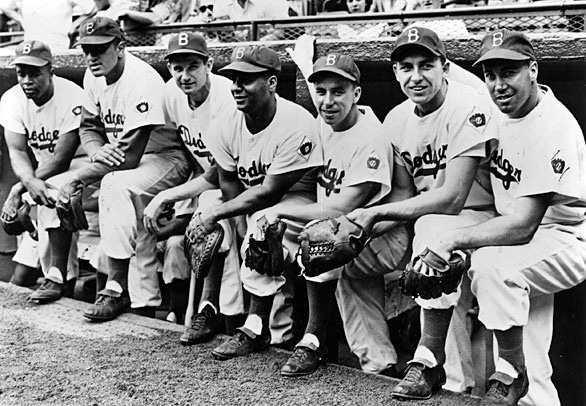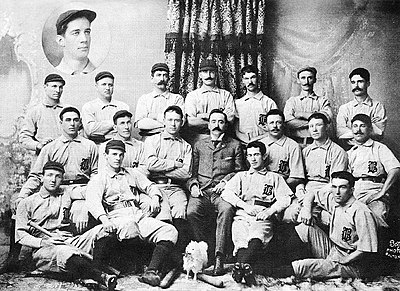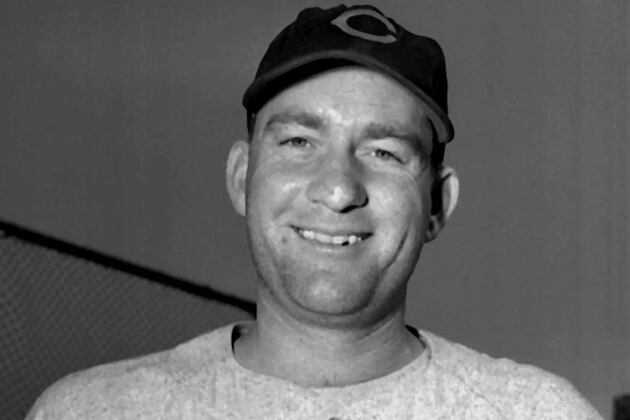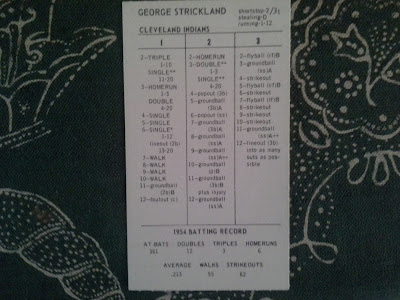| Warren Spahn takes aim at Sputnik courtesy http://baseballhall.org/ |
Restless, and having multiple seasons left unexplored (1948, 1953, 1960, 1961, and 1967 among others), I decided to create yet another league. I gathered many of the National League pennant winners from the years 1948 thought 1964, tossed in a couple of sub-par, but personally interesting teams from 1967, and created the "NL Champions League." And, though the NL was dominated int the 50s by three franchises (the Brooklyn/LA Dodgers, the New York Giants, and the Milwaukee Braves won 9 of the 10 titles in the decade), there is a surprising variety of teams to choose from when one opens the window to as late as 1964: I've got every franchise but the hapless Chicago Cubs represented at least once in this 16-year era.
Here are the teams, broken up into the Fifties and Sixties divisions:
| Fifties | |
| YEAR | TEAM |
| 1948 | Boston Braves |
| 1950 | Philadelphia Phillies |
| 1953 | Brooklyn Dodgers |
| 1954 | New York Giants |
| 1957 | Milwaukee Braves |
| 1967 | New York Mets |
| Sixties | |
| YEAR | TEAM |
| 1960 | Pittsburgh Pirates |
| 1961 | Cincinnati Reds |
| 1962 | San Francisco Giants |
| 1963 | Los Angeles Dodgers |
| 1964 | St. Louis Cardinals |
| 1967 | Houston Astros |
The 1967 Mets and Astros are the obvious exceptions to the theme but a) it's always good to have some below-average teams to prevent an awful parity from settling in and b) they feature so many cool players (Tom Seaver, Joe Morgan, Jimmie Wynn, and Rusty Staub, for example).
Though I'm just a few weeks into this new league there have been several noteworthy games to share:
Pitching feats:
- Warren Spahn (BON48) outdueled Curt Simmons (PHI50) in the second game of the year in a 3-0 shutout. Simmons was undone by some poor defense and actually gave up just one earned run.
- Bubba Church (PHI50) came back the next day to fire a 1-hitter in a 1-0 victory over the Boston Braves. Jeff Heath's triple with one out in the 8th spoiled Church's attempt at immortality - he had retired 22 straight batters to start the game and Heath was the only baserunner he allowed. This close to a perfect game. Bill Voiselle (BON48) gave up 1 unearned run in 8 innings of stellar work.
- Johnny Antonelli (NYG54) and Carl Erskine (BKN53) locked horns for 11 innings, each giving up just one run. Whitey Lockman's 2-run HR off Clem Labine in the 12th won it for the Giants.
- Tom Seaver (NYM67) went 7 innings without giving up an earned run in his debut, but left on the back end of a 4-3 score, victimized by two infield errors, good for 4 runs.
- Billy O'Dell (SFG62) made an Orlando Cepeda HR hold up in the Giants' opener against the 1963 Dodgers. Don Drysdale went the distance for LA and was the hard-luck, 1-0 loser.
- The next day, Sandy Koufax (LAD63) struck out 13 and made a first-inning run hold up against Jack Sanford (SFG62) to complete the twin 1-0 set of games.
Batting feats:
- Brooklyn scored 7 runs in an inning two separate times against the Giants in the Polo Grounds . . . and it almost wasn't enough! A 7-run seventh in their second game was nearly wiped out by a 6-run Giants' 8th . . .Homers by Gil Hodges and Carl Furillo provided the extra margin in an 11-8 victory. In the finale, the Brooklyns jumped out 7-0 in the first, then hung on to win 8-7 thanks, again, to another Carl Furillo late-inning HR.
 |
| The Boys of Summer courtesy http://www.thinkbluela.com/ |
- Dick Groat (STL64) recorded the league's first 5-5 game against the 1967 Houston Astros, leading the Redbirds to a 6-4 victory.
It's been lots of fun getting started in this league. I promise to post standings as it matures.
























